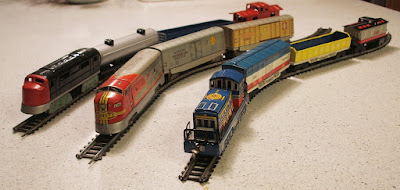 |
| With no reference materials available, how can these be identified? |
That soon launched a search for enough track to complete a circle so I could run the thing. And in the process, I discovered strange similarities between toys from competing manufacturers -- and virtually no information about them.
I continued on, eventually making a small layout for the train, and populating it with Japanese toy cars of the era (chronicled in the Straco Express Layout series of posts). There also seemed to be very little information available for these low-end Japanese toys.
When I was invited to give a talk on Japanese postwar tin toy cars, (part of the Collecting -- and Collecting Information series) I easily found some materials written about the high-end car models of the Japanese toy lines, but not much else. I ended up having to piece together what I could, using Ebay product photos as my primary resource.
And that leads me to this series. Do you have a Lionel train set, or a random Lionel train car or two? There are multiple listings and histories available to help you identify what set your car belongs to, and a complete inventory of what originally came with the set. That latter bit of info can be helpful if you're considering purchases a set.
Similar research has been done for virtually all the toy train manufacturers -- Gilbert (American Flyer), Marx, Dorfan, Haffner, Ives, et al. The offerings of European companies such as Marklin and Hornby are also extensively documented.
Not so postwar Japanese tin toy train sets. Part of the reason might be because they were all self-contained. All of the above-mentioned manufacturers sold sets, but they also sold accessories (extra track, buildings, rolling stock) so you could add to it. All of the Japanese sets I've found so far have no such option. They have all the track you need, the power pack, the train -- and that's it. The sets were designed as inexpensive, single-purchase items.
Over the course of researching for my talk, I kept running across listings for these sets. And as I looked at the images carefully, I saw boxes with lots of useful information. I also saw many mismatched and misidentified sets.
So I've decided to just online information as best I can, and try to pull together some type of listing of sets and set contents for the various manufacturers. This is going to be a slow process, and one you'll see unfold in this blog.
If you have any information about the train sets produced in the 1950s and 1960s by ALPS, Bandai, Cragstan, Haji, Mizuna, Modern Toys, Nomura, Yonezowa or others, please leave a comment.
I'll need all the help I can get for this project!
Hello!
ReplyDeleteI was surfing for info on low-end Japanese toy train sets and found your blog.
In my mother-in-law's attic we found a Continental Flyer set #167 that is yet another variation from what you've found.
Our set's box has the same basic die-cut, cellophane lid, but with a drastically different font. The engine is plastic, the track is all-plastic molded type, yet all three cars are tin!
Let me know if you'd like some photos.
Jeff
opussurf(at)verizon(dot)net
I know this is late, but I love this blog! I recently obtained two sets made by sakai, I believe that are tin litho and battery operated. One came in the original box, the other just the label cut out from the box top. Thanks so much for the info!
ReplyDelete